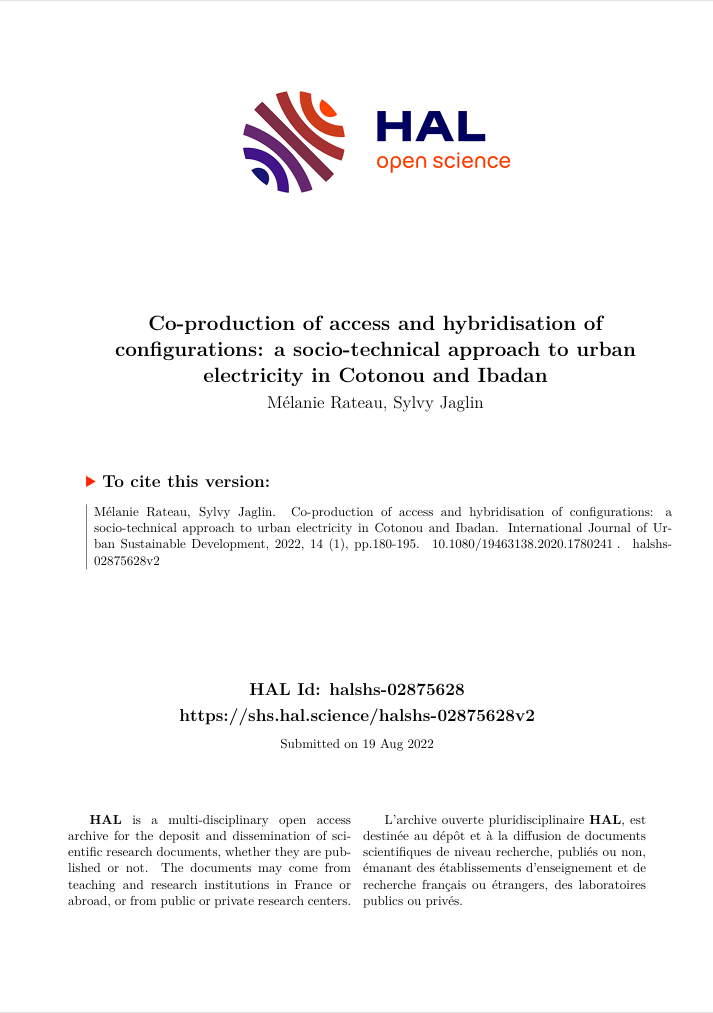Co-production of access and hybridization of configurations: a sociotechnical approach to urban electricity in Cotonou and Ibadan
 |
article Aug 2022 ; 18 pages
Aut. Mélanie Rateau & Sylvy Jaglin
Ed. HAL-SHS - Lyon - 2 édition
Téléchargeable sous format: PdF
Téléchargeable chez l'éditeur
Résumé:
L’article analyse les dynamiques d’accès à l’électricité dans deux villes d’Afrique de l’Ouest : Cotonou (Bénin) et Ibadan (Nigeria). En raison de la mauvaise qualité de l’approvisionnement par le réseau électrique national, les ménages développent des stratégies diversifiées pour accéder à l’électricité, s’appuyant sur différents dispositifs socio-techniques. Dans un premier temps, les auteurs montrent que l’accès à l’électricité repose sur des processus de co-production, qu’il convient d’appréhender à partir d’une perspective multi-échelle – allant du niveau domestique à l’échelle urbaine. Ensuite, ils soutiennent que l’attention portée aux dimensions socio-techniques et spatiales des arrangements de co-production permet d’interpréter les configurations électriques urbaines et leur évolution. Ils démontrent ainsi que ces processus de co-production, mobilisant une multiplicité d’acteurs et de technologies pour répondre à une demande urbaine croissante et diversifiée en électricité, alimentent un mouvement continu d’extension et d’hybridation des configurations électriques à l’échelle des villes. Ce phénomène ouvre des perspectives intéressantes sur les mutations du secteur électrique en Afrique subsaharienne. Abstract:
The article examines the dynamics of access to electricity in two West African cities: Cotonou (Benin) and Ibadan (Nigeria). Due to poor supply from the grid, households are developing varied ways of accessing electricity, based on different socio-technical dispositifs. In this paper the authors first demonstrate that access to electricity is based on co- production processes that must be approached from a multi-scale perspective (from the household to the urban scale). They then argue that particular attention to the socio-technical and spatial dimension of co-production arrangements makes it possible to interpret urban electrical configurations and their evolution. They thus show that co-production processes, relying on many actors and technologies to meet a growing and diversified demand for electricity in cities, support an ongoing move- ment of extension-hybridisation of electricity configurations on an urban scale, thus offering an interesting perspective on power changes in sub-Saharan Africa. Sommaire:
1. Introduction
2. Deciphering electricity configurations through co-production and households’ practices in Cotonou and Ibadan
2.1. Defining co-production of access to electricity
2.2. From co-production processes to electricity configurations: analysing electricity access in its urban and technological plurality
3. Methods: grounded study in Cotonou and in Ibadan
4. Heterogeneity of households’ practices to access electricity
4.1. An erratic grid supply
4.2. Spiderwebs on the margins of the grid
4.3. A diverse range of off-grid technologies
4.4. Emerging electricity storage technologies
5. Situated co-production arrangements in response to distinct rationales
5.1. In Cotonou: the grid at the heart of the co-production of electricity access
5.2. In Ibadan: practices of securing electricity supply restricted by purchasing power
5.3. In the well-to-do districts of both cities: aggregation of alternative solutions to the grid
6. Conclusion
Public-Cible:
Mots clefs: |
accès à l’électricité (CI) (DT) (OP) (ope) , réseau électrique, réseau national (CI) (DT) (OP) (ope) , urbain (CI) (DT) (OP) (ope) |
Pays concernés: |
Editeur/Diffuseur: |
|
HAL-SHS
-
Hyper Article en Ligne - Sciences de l'Homme et de la Société - Lyon |
En cas de lien brisé, nous le mentionner à communication@pseau.org